In recent years, domestic violence against women has emerged as an important social problem in rural India. It has attracted the attention of a wide spectrum of agencies, from healthcare providers to law enforcement authorities1. The extent of the health consequences of this problem is unknown.
According to world-wide studies, one in three women experience violence in an intimate relationship at some point in their lives2. Such violence may consist of physical and/or psychological elements. Physical violence is defined as the use of physical force against another person that results in physical, sexual or psychological harm and includes beating, kicking, slapping, stabbing, shooting, pushing, biting, pinching, strangling, among others. Psychological violence is defined as the intentional use of power, including threat of physical force, against another person, that can result in harm to family life, livelihood, physical, mental, spiritual, moral or social development and includes verbal abuse, bullying/mobbing, harassment, intimidation and threats.
Even in developed nations such as the USA, figures suggest that more than 1.5 million women are physically and/or sexually abused by their marital partner each year3. A similar study from the UK revealed that the prevalence of domestic violence in cohorts of pregnant women of Northern England is 17%4.
Statistical evidence on the actual prevalence of domestic violence against women in India is scant. The few studies available indicate that physical abuse of Indian women is high, ranging from 22% to 60% of women surveyed5,6.
In a study from northern India, 18-45% of men acknowledged having physically abused their wives at some time7. Another study from northern India revealed that, compared with men raised in non-violent homes, men raised in violent homes were significantly more likely to be physically/sexually abusive to their wives8. Also, wife abuse in the second generation was found to be attributable to parent-to-parent violence in the first generation8.
The nature of domestic violence, its causes, and its prevalence must be fully understood in order to plan effective prevention and intervention strategies. The present study generated population-based data to determine the magnitude of family violence as well as its characteristics and consequences, in the Saoner district of Maharashtra, central India (Fig 1). The present study was undertaken with support from the OXFAM (India) Trust, the International Clinical Epidemiology Network (INCLEN). Nagpur India SAFE field staff helped in the data collection process.
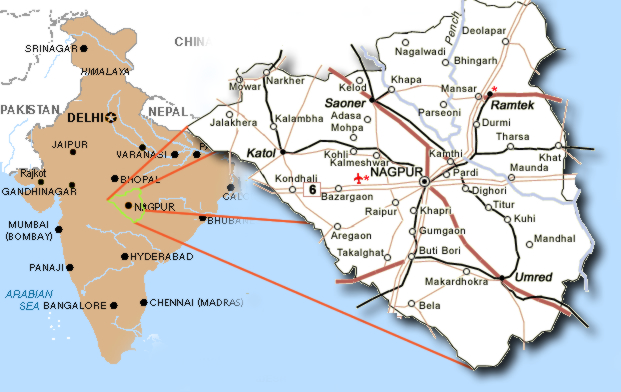
Figure 1: Map ofthe study area in central India.
Methods
Focus groups
Prior to conducting a cross-sectional survey of families, the investigators and interviewers conducted focus group studies of 10 women each, in the age group 18-40 years, in three randomly selected villages of rural Maharashtra. The goal of the focus group discussions was to obtain local advice on the study procedures and implementation, as well as to understand the local norms for appropriate and non-appropriate behavior between husband and wife, and parents and child.
Study design and development
Eligible women from 500 households in Saoner district of Maharashtra, central India were interviewed. Demographic characteristics and other characteristics of social ecology hypothesized to be related to violence against women (eg the husband's alcohol abuse, residential instability, poor neighborhood support, gender biases, child disobedience, child health problems, and maternal depression) were also included. The instrument for this study was formulated in English, translated into Marathi, the local language, and then back translated. Comparisons were made with the original version and modifications were implemented wherever necessary to ensure equivalence in meaning between the English and translated version. It was pre-tested in 25 households.
Procedure
The study was conducted in five villages in the Saoner district of Maharashtra in central India. Villages in this district were stratified into two sizes: large (>2000 population) and small (<2000 population). Five villages were randomly selected and proportionately sampled. Households were approached up to three times, to screen for eligibility. Households containing a married woman with at least one child under 18 years were considered eligible. After obtaining permission from the village authorities, trained interviewers approached homes from a standardized starting point, screening for eligible households from all four quadrants until the sample size for that villages was reached. When more than one eligible woman resided in a household, the interviewer randomly selected one eligible woman for interview. Similarly, when the selected woman had more than one eligible child, one eligible child was randomly selected to serve as the referent child for survey questions.
The field supervisor and interviewers were female social workers with prior experience of working in the rural context. They received extensive standardized training in all aspects of the study protocol prior to entry into the field. Because illiteracy was a concern in targeted villages, the informed consent procedure was verbal. Eligible women were invited to participate in a study related to maternal and child health that consisted of an interview on 'private and sensitive family matters'. After receiving consent, all face-to-face interviews were conducted privately, either within or close to the woman's residence.
Data analysis
Data analysis included generating descriptive statistics for the variables of interest.
Measures
Violence against a woman was defined as 'physical assault or psychological abuse of the "target woman" by her husband or other family members'. Physical assault was defined as 'any force, including sexual, committed by her husband or other family members that was perceived by the victim as threatening, harmful, controlling or fear inducing'. Psychological abuse was defined as the intentional use of power, including threat of physical force, against another person, that can result in harm to family life, livelihood, physical, mental, spiritual, moral or social development and includes verbal abuse, bullying/mobbing, harassment, intimidation and threats. Both past and current violence was assessed. The term 'current violence' included incidents that had occurred within the past 6 months. The term 'past violence' included incidents that occurred at any time prior to the last 6 months during married life. Also identified was the timing of the initiation of such violence.
Ethical considerations
Verbal consent was obtained before the interview started. Target women were informed that they did not have to answer any question if they did not want to, and that they could withdraw from participation at any point in the study. Privacy was maintained for participants in both focus group discussions and also interviews. The participants were assured that the information would not be divulged to any individual under any circumstances and would be treated as strictly confidential. The study methodology was reviewed and approved by the Ethical Review Board of Government Medical College, Nagpur, India.
Results
Participation rate
79% (n = 500) of the eligible women selected for survey in the five villages, agreed to participate and completed the interview. Non-participants were women who said they were not interested or were too busy with household tasks to afford the time (n = 77), women who could not be found at home after three visits (n = 47), and women who were not permitted to be interviewed by their husbands or mothers-in-law (n = 16). One interview was attempted, and then aborted, because privacy could not be maintained.
Focus groups
The married women in the focus groups in the age group of 18-40 years agreed that within local villages, nearly all women had been abused by their husbands. The authors achieved a clear distinction of circumstances of when, according to the local mindset, it was described as 'OK' for a man to beat his wife. For instance, a man beating his wife in front of a non-family member was considered abusive.
Sociodemographic characteristics
The characteristics of the 500 women interviewed are described, as are those of their husbands, and the household characteristics (Tables 1,2). The women's ages ranged from 18-60 years, with a mean age of approximately 30 years. Almost one-third (30.4%) had no formal education. More than one-third (34.1%) described themselves as illiterate. The women's husbands were better educated, with 20.8% having attended school for more than 10 years. Almost 90% of the families were Hindu and more than half (56%) lived in one-room dwellings. There were no single-adult households; close to half (46.2%) had three or more adults in the household. Likewise, almost half (49.4%) had three or more children. The mean household-crowding ratio was approximately four persons per room.
Table 1: Demographic characteristics of the 500 women interviewed and their husbands
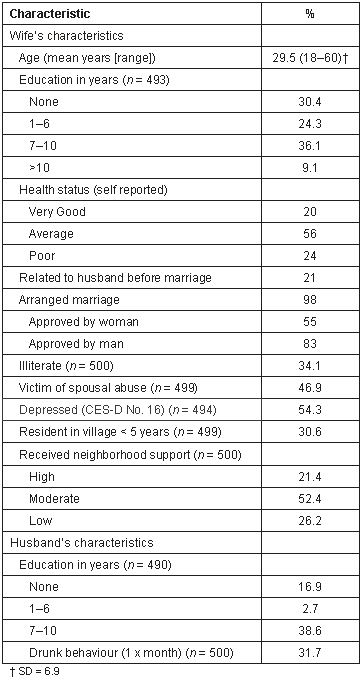
Almost one-third of the women (30.6%) reported having lived in the village for less than 5 years. Slightly more than one-quarter of the women (26.2%) were classified as having low neighborhood support, 21.4% had high neighborhood support, and all others were classified in the moderate category. More than half were at or above the clinical cut-off point for depression on the Center for Epidemiologic Studies Depression Scale (CES-D)9,10 and approximately one-third said that their husbands became drunk at least 1-3 times per month.
Table 2: Family/household characteristics of the 500 women interviewed
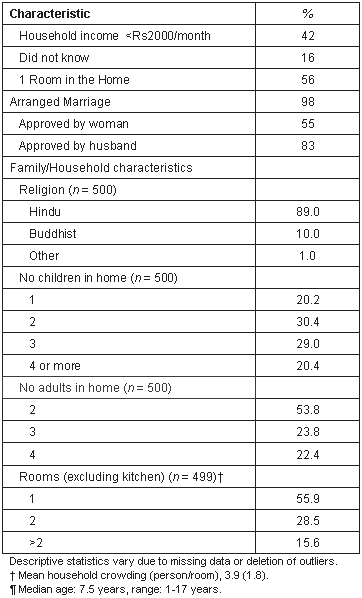
Frequency of violence
The researchers did not use the terms 'violence', 'abuse' or 'assault' but asked if the women had been slapped, kicked, hit or beaten by their husband. Violence against the women was divided into physical and psychological abuse.
Physical abuse: The frequency of reported assault type is shown (Table 3). Almost half the women reported having been slapped during their marriage, and almost one-quarter reported being beaten in the past 6 months.
Table 3: Frequency of assault type
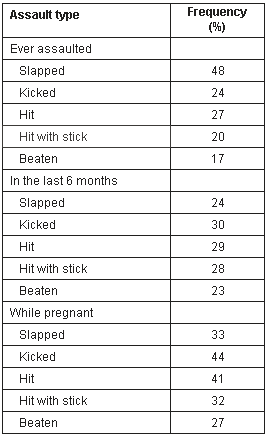
There was a high frequency alleged of physical assault by husbands while the woman was pregnant. Almost half of the women reported having been kicked during pregnancy.
During the project period, the interviewers came across two women who alleged burn injuries at the hands of their husbands (burn wounds visible).
Psychological abuse: The frequency of reported psychological abuse is shown (Table 4). Of the women interviewed, 38% reported having been verbally insulted by their husband with a median of 11 times during the past 6 months. Almost one in five of the women (18%) alleged threats of harm, and 12% reported being specifically threatened by their husbands with having kerosene oil poured on them in order to set them on fire.
Table 4: Frequency of psychological abuse of women by their husbands

Reasons for abuse
The reasons cited most often for abuse of women by husbands included: economic stress in the family, complaints by the mother-in-law, not preparing meals on time/not cooking meals properly, not caring for children properly, visiting her parents and talking to other men (Table 5).
Women in the study frequently attributed violence to proximate causes like 'mistakes' in running the household. In-depth interviews revealed that women felt that their husband's anger was aggravated when they resisted verbal abuse by defending themselves, or if they used harsh language. These findings revealed that the husbands assumed the role of task-masters and even petty mistakes on the wife's part in the running of the household gave them an excuse to become violent towards their wife. Absolute dominance was demanded by such husbands, and even the slightest attempt at self-defence by the women fueled their anger.
Although marital violence in India is often equated with dowry violence, only 8% of the women reported being harassed because of an inadequate dowry.
Table 5: Reasons cited most often for abuse of women by their husbands
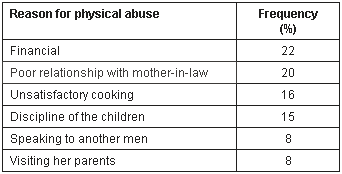
Medical treatment
30% of the physically assaulted women reported that they required medical care for their injuries.
Discussion
Women who are abused are often reluctant to admit to the violence, in part because of shame, fear and a belief that people will not understand or be able to help. In the present study, the ability to access the level of violence against women was due to the intense, standardized training of the interviewers and the skilled interview that was conducted in total privacy. To our knowledge this study is the first house-to-house survey conducted in the Indian community in relation to this issue. Not only is the frequency of violence reported in the present study surprising, but also the evidence of the repetitive nature of this violence.
Two-thirds of the women interviewed reported some form of psychological or physical abuse. Of the total sample, half reported physical abuse. 38% described abusive language, belittlement, and threats. This large proportion resonates with high levels of violence recorded in other parts of India5-8.
Almost half of the women in the present study admitted to physical abuse during pregnancy. Such violence during pregnancy could also be one of the factors contributing to the high prevalence of fetal loss11. However, further studies are needed to shed more light on this association.
In the USA the cost of family violence is thought to be US$12.6 billion annually12. Because 30% of the physically assaulted women in the present study required medical care, these data suggest that violence against women may cause significant costs to the Indian healthcare system.
This study raises the issue of whether rural health professionsl should incorporate screening for violence in their routing care of women. A recently published review of studies from the USA, Australia and New Zealand found insufficient evidence to justify such screening13. However the relevance of such a review to this setting can be questioned when all the studies included were from the USA, Australia or New Zealand and there was no mention of any rural context in the review.
Conclusion
The present study indicates that the magnitude of violence against women in rural villages in India is similar to that found by other Indian and Western authors. This domestic violence is a significant public health problem. The results of this study should be used to develop informed interventions aimed at reducing family violence. This research suggests that, in the present Indian rural setting, solutions to domestic violence must be found within the social structure of the family and within the community setting.
Acknowledgements
Support for this research was provided by OXFAM (India) Trust, Ref. # Mah 229A6. Oxfam (India) is a member of Oxfam International. The authors also gratefully acknowledge the support of the International Clinical Epidemiology Network (INCLEN) in the development of this project, the work of Nagpur India SAFE field staff who collected the data, and the women who made the study possible by freely sharing their daily lives.
References
1. Anon. Violence against women: an issue of human rights. Gender Action 1997; 1: 1,4,8.
2. WHO. Violence against Women. Geneva: WHO, 1997.
3. US Department of Justice. Crime Data brief. Washington: US Department of Justice, 2000.
4. Johnson JK, Haider F, Ellis K, Hay DM, Lindow SW. The prevalence of domestic violence in pregnant women. British Journal of Gynaecology 2003; 110: 272-275.
5. Rao V. Wife-Beating in rural South India: A quantitative and econometric analysis. Social Science and Medicine 1997; 44: 1169-1180.
6. Mahajan A. Instigators of wife battering. Violence against women. Jaipur: Arihand Publishers, 1990.
7. Martin SL, Tsui AO, Maitra K, Marinshaw R. Domestic violence in northern India. American Journal of Epidemiology 1999; 150: 417-426.
8. Martin SL, Moracco KE, Garro J et al. Domestic violence across generations: findings from northern India. International Journal of Epidemiology 2002; 31: 560-572.
9. Radloff LS. The CES-D scale: A self report depression scale for research in the general population. Applied Psychological Measurement 1977; 1: 385-401.
10. Hann D, Winter K, Jacobsen P. Measurement of depressive symptoms in cancer patients: evaluation of the Center for Epidemiological Studies Depression Scale (CES-D). Journal of Psychosomatic Research 1999; 46: 437-443.
11. McFarlane J, Parker B, Soeken K, Bullock L. Assessing for abuse during pregnancy: Severity and frequency of injuries and associated entry into prenatal care. JAMA 1992; 267: 3176 -3178.
12. Waters H, Hyder A, Rajkotia Y, Basu S, Rehwinkel JA, Butchart A. The economic dimensions of interpersonal violence. Department of Injuries and Violence Prevention. Geneva: World Health Organization, 2004.
13. Ramsay J, Richardson J, Carter YH, Davidson LI, Feder G. Should health professionals screen women for domestic violence? A systematic review. BMJ 2002; 325: 314-327.
Abstract
Introduction: In recent years violence against women has emerged as an important social problem in India. It has attracted the attention of a wide spectrum of agencies, from healthcare providers to law enforcement authorities. This study attempted to determine the characteristics and the magnitude of physical and psychological violence against women in rural Maharashtra, central India.
Methods: The study initially undertook focus group activities. This was followed by the formulation of the survey instrument in English, which focused on partner violence and child disciplinary practices. After pre-testing the instrument in 25 households, the actual study was conducted by trained interviewers in five randomly selected villages of rural Maharashtra. The study included 500 households (sample size = 500 women, eligible if they had at least one child less than 18 years of age).
Results: The results revealed that of the women interviewed, almost one-third (30.4%) had no formal education and the women's husbands were better educated. More than half the women lived in one-room dwellings and were at or above the clinical cut-off point for depression on the Center for Epidemiologic Studies Depression Scale (CES-D). 38% of the women were verbally insulted by their husband with a median of 11 times in past 6 months. Almost half the women said they had been slapped, hit, kicked or beaten by their husbands at some time. 24% of the women reported having been kicked by their husbands at some point during their married life, and 44% were reportedly kicked during pregnancy. 12% were specifically threatened by their husbands with having kerosene oil poured on them to set them on fire. 30% of the physically assaulted victims required medical care.
Conclusions: Considering the prevalence of domestic violence, health-care providers should screen for domestic violence in routine practice. In addition, protocols should be developed for referral of abused women to appropriate community resources. In the present Indian rural setting, solutions to domestic violence must be found within the social structure of the family and the community.
Keywords: domestic violence, dowry, family violence, human rights, physical abuse of women, rural Maharashtra, violence against women, women's rights.
You might also be interested in:
2014 - Gender and age are associated with healthy food purchases via grocery voucher redemption
2005 - The quality of procedural rural medical practice in Australia

